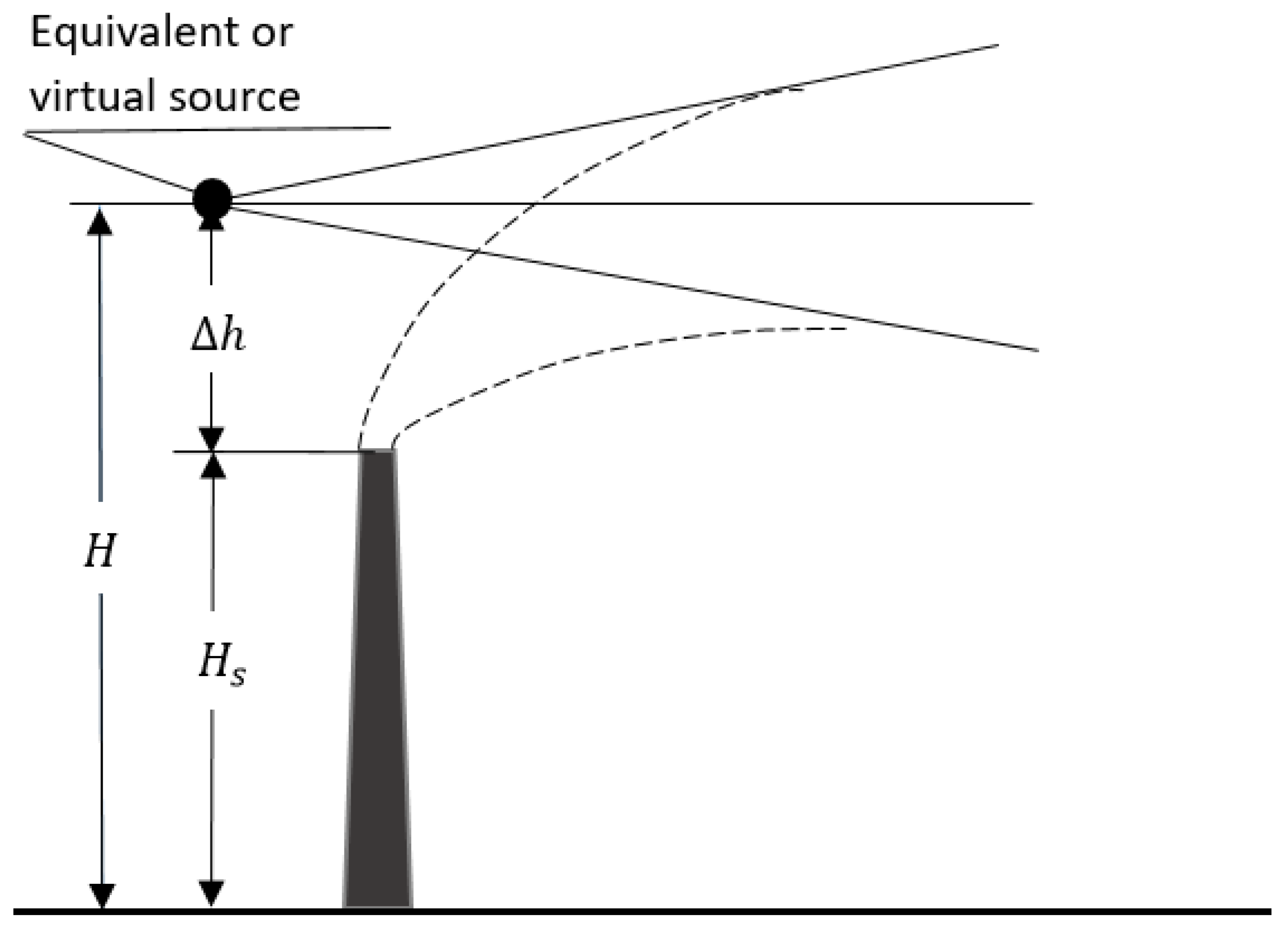Reconstructing Pollutant Dispersion Information by Defining Exhaust Source Parameters with Inverse Model †
Abstract
:1. Introduction
- Effective height of the point emission source stack. The effective height depends on the velocity of the pollutant released from the stack that can be defined by continuous monitoring. Such monitoring is not in common practice.
- Emission rate from the stack.
- Measuring particle concentrations at multiple locations around the plant with the PM 2.5 sensor and storing data in the Raspberry Pi.
- Computing emission rate, effective emission source stack height and standard deviations of concentration with model using concentrations collected in previous step.
- Calculating concentrations around the plant with the direct emission dispersion model.
- Testing the model’s accuracy by comparing concentrations defined in the previous step with the dispersion model and experimental data at the same points, different from those defined in the first step.
2. Inverse Reconstructing Model and Solution with Theory of Hypernumbers
3. Conclusions
Author Contributions
Funding
Institutional Review Board Statement
Informed Consent Statement
Data Availability Statement
Conflicts of Interest
References
- Macdonald, R. Theory and Objectives of Air Dispersion Modelling. In Modeling Air Emissions for Complianc; MME 474A Wind Engineering (Course Notes); University of Waterloo: Waterloo, ON, Canada, 2003; 27p. [Google Scholar]
- Awastthi, S.; Khare, M.; Gargawa, P. General Plume Dispersion Model (GPDM) for Point Source Emissions. Environ. Model. Assess. 2006, 11, 267–276. [Google Scholar] [CrossRef]
- Lushi, E.; Stockie, J. An inverse Gaussian Plume Approach for Estimating Atmospheric Pollutant Emissions from Multiple Point Sources. Atmos. Environ. 2010, 44, 1097–1107. [Google Scholar] [CrossRef] [Green Version]
- Seibert, P. Inverse dispersion modelling based on trajectory-derived sourcereceptor relationships. In Air Pollution Modeling and Its Application XII; Gryning, S.E., Chaumerliac, N., Eds.; Plenum: New York, NY, USA, 1997. [Google Scholar]
- Burgin, M. Nonlinear partial differential equations in extrafunctions. Integr. Math. Theory Appl. 2010, 2, 17–50. [Google Scholar]
- Burgin, M.; Dantsker, A.M.; Esterhuysen, K. Lithium Battery Temperature Prediction. Integr. Math. Theory Appl. 2014, 3, 319–331. [Google Scholar]
- Burgin, M.; Dantsker, A. Real-Time Inverse Modeling of Control Systems. In Hypernumbers; Nova Science Publishers: New York, NY, USA, 2015. [Google Scholar]
- Burgin, M.; Dantsker, A.M. A Method of Solving of Operator Equations of Mechanics by means of the Theory of Hypernumbers. Not. Acad. Sci. Ukr. 1995, 8, 27–30. [Google Scholar]

Publisher’s Note: MDPI stays neutral with regard to jurisdictional claims in published maps and institutional affiliations. |
© 2022 by the authors. Licensee MDPI, Basel, Switzerland. This article is an open access article distributed under the terms and conditions of the Creative Commons Attribution (CC BY) license (https://creativecommons.org/licenses/by/4.0/).
Share and Cite
Dantsker, A.; O’Brian, P. Reconstructing Pollutant Dispersion Information by Defining Exhaust Source Parameters with Inverse Model. Proceedings 2022, 81, 145. https://doi.org/10.3390/proceedings2022081145
Dantsker A, O’Brian P. Reconstructing Pollutant Dispersion Information by Defining Exhaust Source Parameters with Inverse Model. Proceedings. 2022; 81(1):145. https://doi.org/10.3390/proceedings2022081145
Chicago/Turabian StyleDantsker, Arkadiy, and Patrick O’Brian. 2022. "Reconstructing Pollutant Dispersion Information by Defining Exhaust Source Parameters with Inverse Model" Proceedings 81, no. 1: 145. https://doi.org/10.3390/proceedings2022081145
APA StyleDantsker, A., & O’Brian, P. (2022). Reconstructing Pollutant Dispersion Information by Defining Exhaust Source Parameters with Inverse Model. Proceedings, 81(1), 145. https://doi.org/10.3390/proceedings2022081145




